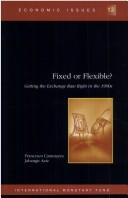| Listing 1 - 5 of 5 |
Sort by
|
Book
ISBN: 1462313795 1452738203 Year: 1993 Publisher: Washington, D.C. : International Monetary Fund,
Abstract | Keywords | Export | Availability | Bookmark
 Loading...
Loading...Choose an application
- Reference Manager
- EndNote
- RefWorks (Direct export to RefWorks)
This paper explores the determinants of expected rates of realignment of the French franc/Deutsche mark exchange rate during the period 1987-1991. It does so by first estimating expected parity changes and then relating these to economic variables that are believed to influence agents’ realignment expectations. Time-varying expected rates of realignment are estimated in two ways: one, by adjusting short-term euromarket interest rate differentials for the expected rate of change of the FF/DM exchange rate within the EMS fluctuation band and two, by the differential in the yield on long-term government bonds. The behavior of the exchange rate within the band is found to be consistent with mean reversion and the expected change is nontrivial. Thus, by filtering out the expected mean reversion within the band from short-term interest rate differentials more precise measures of expected changes in the central parity are obtained. Realignment expectations are found to be closely related to the evolution of fundamental economic variables and, for shorter horizons, the position of the franc in the fluctuation band.
Crawling peg --- Currencies --- Currency --- Exchange rate adjustments --- Exchange rates --- Foreign Exchange --- Foreign exchange --- Government and the Monetary System --- Income economics --- Interest Rates: Determination, Term Structure, and Effects --- International Monetary Arrangements and Institutions --- Labor --- Labour --- Monetary economics --- Monetary Systems --- Money and Monetary Policy --- Money --- Payment Systems --- Regimes --- Standards --- Unemployment rate --- Unemployment --- Unemployment: Models, Duration, Incidence, and Job Search --- Germany
Book
ISBN: 1455222674 1455229571 Year: 1998 Publisher: Washington, D.C. : International Monetary Fund,
Abstract | Keywords | Export | Availability | Bookmark
 Loading...
Loading...Choose an application
- Reference Manager
- EndNote
- RefWorks (Direct export to RefWorks)
This paper examines the recent evolution of exchange rate policies in the developing world. It looks at why so many countries have made a transition from fixed or "pegged" exchange rates to "managed floating" currencies. It discusses how economics perform under different exchange rate arrangements, issues in the choice of regime, and the challenges poised by a world or increasing capital mobility, especially when banking sectors are inadequately regulated or supervised.
Foreign Exchange --- Money and Monetary Policy --- Monetary Systems --- Standards --- Regimes --- Government and the Monetary System --- Payment Systems --- Currency --- Foreign exchange --- Monetary economics --- Exchange rates --- Exchange rate arrangements --- Exchange rate flexibility --- Currencies --- Conventional peg --- Money --- Hong Kong Special Administrative Region, People's Republic of China

ISBN: 1557756929 Year: 1998 Publisher: Washington, D.C. International Monetary Fund
Abstract | Keywords | Export | Availability | Bookmark
 Loading...
Loading...Choose an application
- Reference Manager
- EndNote
- RefWorks (Direct export to RefWorks)
Book
ISBN: 146230964X 1451991495 1281973777 1451895429 9786613793980 Year: 2000 Publisher: Washington, D.C. : International Monetary Fund,
Abstract | Keywords | Export | Availability | Bookmark
 Loading...
Loading...Choose an application
- Reference Manager
- EndNote
- RefWorks (Direct export to RefWorks)
The paper seeks to identify common characteristics among a variety of macroeconomic and financial variables for a large sample of currency crises in industrial countries and emerging market economies. It covers crises which culminated in large currency depreciation as well as those in which there was a substantial loss of foreign reserves. The analysis involves comparing the monthly or annual pattern of movement of the various macroeconomic and financial variables around the time of crisis to their behavior during tranquil periods. The robustness of the results is tested by subdividing the sample into different types of currency crises and carrying out a similar analysis for each.
Banks and Banking --- Finance: General --- Financial Risk Management --- Inflation --- Macroeconomics --- Foreign Exchange --- Current Account Adjustment --- Short-term Capital Movements --- Financial Crises --- General Financial Markets: General (includes Measurement and Data) --- Price Level --- Deflation --- Economic & financial crises & disasters --- Finance --- Currency crises --- Financial crises --- Emerging and frontier financial markets --- Banking crises --- Financial markets --- Prices --- Financial services industry --- United States
Book
ISBN: 1462330851 1452705887 1281961671 1451894457 9786613793867 Year: 2000 Publisher: Washington, D.C. : International Monetary Fund,
Abstract | Keywords | Export | Availability | Bookmark
 Loading...
Loading...Choose an application
- Reference Manager
- EndNote
- RefWorks (Direct export to RefWorks)
This paper investigates empirically the relevance of external, domestic, and financial weaknesses as well as trade and financial linkages in inducing financial crises for a sample of 61 emerging market and industrial countries. A panel probit estimation finds these economic indicators to be significant for emerging market countries during the Mexican, Asian, and Russian crises. In particular, the indicators of vulnerability to international financial spillover (common creditor) and of financial fragility (reserve adequacy) are highly significant and appear to explain the apparent regional concentration of these crises. Exchange rate regimes and capital controls, however, do not seem to matter.
Finance: General --- Financial Risk Management --- Foreign Exchange --- Macroeconomics --- Current Account Adjustment --- Short-term Capital Movements --- International Lending and Debt Problems --- Open Economy Macroeconomics --- International Financial Markets --- General Financial Markets: General (includes Measurement and Data) --- Financial Crises --- Finance --- Economic & financial crises & disasters --- Currency --- Foreign exchange --- Emerging and frontier financial markets --- Financial crises --- Exchange rate arrangements --- Currency crises --- Currency markets --- Financial markets --- Financial services industry --- Foreign exchange market --- Brazil
| Listing 1 - 5 of 5 |
Sort by
|

 Search
Search Feedback
Feedback About UniCat
About UniCat  Help
Help News
News